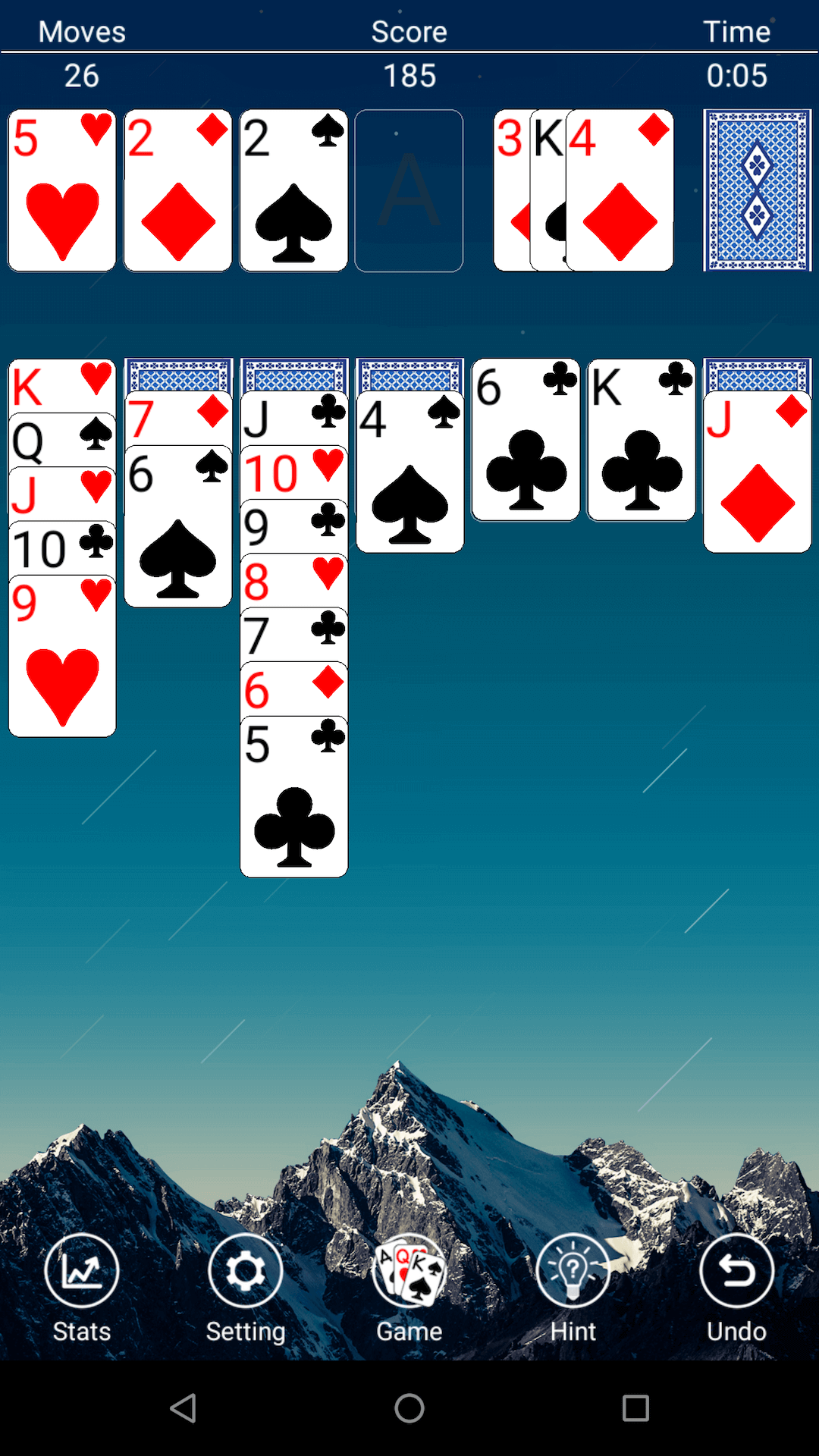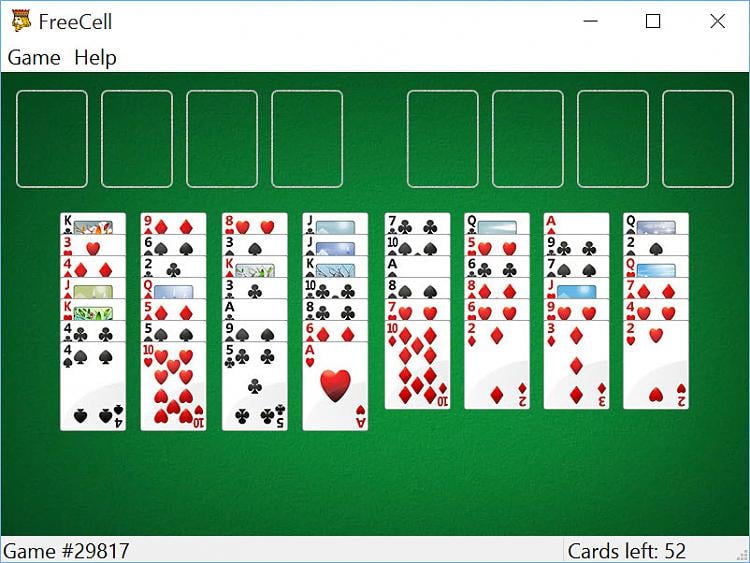How to play FreeCell?
Use four extra cells to move cards around as you try to clear all cards from the table.
- Freecell solitaire is a variation of solitaire that includes spaces to hold cards, or 'free cells.' The free cells in the upper left act as a maneuvering space. You can use the free cells strategically to transfer all cards from the tableau to the foundation slots. Play Free Cell Solitaire today to.
- Introduction to Freecell. Classic FreeCell is played with one 52-card deck of standard playing cards. It's a modification of the solitaire game called Baker's Game.The only real difference is that in FreeCell, they are built by alternate (red and black) colors, while in Baker's Game cards are built by suit.
- About FreeCell Solitaire Online. The name of the game, FreeCell, comes from the four free cells in the top-left corner of the game board which can be used to temporarily store cards. The game was invented by Paul Alfille as a modification of an older game. Alfille also created a first FreeCell Solitaire video game in 1978.
FreeCell is a combination of luck and tactics. The luck is from what cards you're dealt, while the tactic comes into play when you need to prepare and calculate for several moves ahead.On the board, you have four blank fields on the left and the right. The ones on the left are called freecells, and the ones on the right are the homecells or the foundation. The goal of the game is to move all cards into the homecells.
The games start with eight columns of cards, all 52 of them, where the first four columns have seven cards, while the other four have six. This arrangement is called the tableau. The cards from there will need to go to the homecells. Each homecell is for one of the card suits, Spades, Hearts, Diamonds, and Clubs. You will need to order them starting from the ace and finishing with the king, making sure that each suit is in its homecell. The freecells are used like temporary holders, where you are able to place the last card in the tableau column to move it out of the way.
All cards from the deck are randomized in the eight columns on the board, and you will need to move them around to put all of them in their homecells in the required order. You have three options to make your move, and they are the only ones you will need to know.
When you start the game, the cards that you are available to move are the ones that are on the bottom of the columns, in other words, if no other card is covering it. If it's an ace, you can move it to a homecell. Moving the cards to a homecell means that you will need to move them with a specific order from ace to the king, making sure every card in that field is with the same suit.
When you move a card to a freecell, the only rule you need to follow is that you can have only one card in one freecell at a certain time. Apart from that, you are free to move any uncovered card there at any time. Even though you are available to use the freecells as much as you want, try to keep them available for future cards you may need to move around.
Before the game begins, you will need to come up with a tactic and plan a few moves ahead of time. This will enable you to plan how to move cards to their homecells or free them to be moved to a freecell or below another card in the columns. To move a free card from one position to another that is not a homecell or freecell there are three rules:
- it needs to be the latest card in the column, uncovered
- the card you intend to place on also needs to be a free one
- the card you move needs to be one card lower and with the opposite color than the card you plan to put it below.
Here is an example: if you have seven of hearts in one column and six of spades in another, you can place the six below the seven. On the other hand, if you have seven of hearts and six of diamonds, then you cannot. Below each black card will need to go a red one, and it needs to be one card lower – five below six, queen below the king, and so on.
During the process of clearing up the board, you will come into a situation where you will manage to clear out an entire column and be left with seven or less. In that case, you can grab any free card and move it to an empty column slot. It doesn't matter which card it is, as long as it is a free one.

The advantage of the game is that all cards are uncovered, meaning that there will be no surprises, and you have the option to plan well ahead. Since the game randomizes the cards, there may be a situation where you will be left with no options or possible moves. There are ways of avoiding this, but if you don't manage to do so, restart the game and try again.

If you like FreeCell, you may also like Spider Solitaire. Also, don't forget to play or the day for classic solitaire also known as klondike solitaire. And if you're looking for new types of games, we have over 500 different solitaire card games. Good luck!
History of FreeCell
FreeCell is one of the most popular card games you can find on most computers. It was first introduced in 1978 by Paul Alfille, who programmed the first computerized version of it as a medical student on a PLATO computer at the University of Illinois.
It was popularized in 1991 when it came preinstalled with every version of Windows. Just like any other card game, there is a unique set of rules that a player must follow to win the game. The game is played with one deck of cards, and even though there is an infinite number of possible deals, don't expect to be able to learn all of them. Mathematically speaking, there are 1.75 times 10 to the power of 64 possible games.
Paul Alfille changed Baker's Game by making cards build according to alternate colors, thus creating FreeCell. He implemented the first computerized version of it for the PLATO educational computer system in 1978. The game became popular mainly due to Jim Horne, who learned the game from the PLATO system and implemented the game as a full graphical version for Windows. This was eventually bundled along with several releases of Windows.
Freecell.net
- Shuffle, then deal the 52 cards face up in 8 columns with each card visible but only the end card of each column fully exposed. Four columns will have 7 cards, the others only 6.
- Apart from the columns, there are four single card free cells and four suit piles (foundations). The objective is to get all the cards into the foundations.
- Single exposed cards may be moved:
- Column to column, placing the card on a card of the next rank and different colour suit. (E.G. Place a red 3 on a black 4.) (Aces are low.). Empty columns may be filled with any suit or rank.
- Column to FreeCell, any exposed card as long as there is an empty cell.
- FreeCell to Column, as column to column.
- Column to suit home pile. Next card in order, starting with the Ace, ending with the King. Each suit is completely independent.
- FreeCell to suit home pile. As column to suit home pile.
Games Free Cell Is On This Computer
